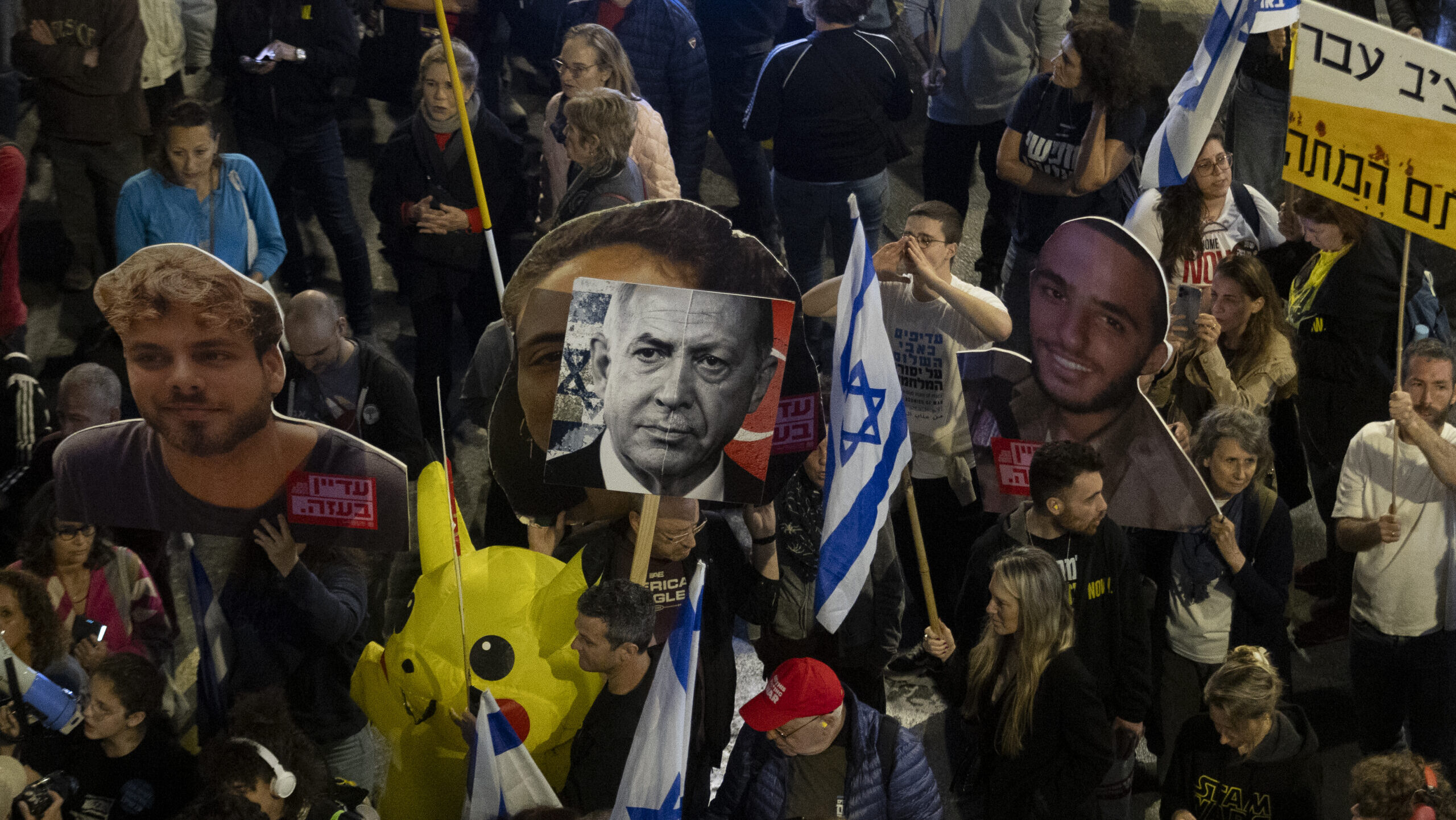Hostage Talks at a Breaking Point—What Will It Take To Bring Them Home?
Families and experts urge Israel to prioritize the release of 59 hostages, criticizing Netanyahu's political calculations amid stalled talks
Avera Mengistu does not speak unless spoken to. He remembers his life before September 7, 2014, when he crossed the security barrier into Gaza and was kidnapped by Hamas. But what happened during his time in Gaza? About that, he remains completely silent.
Hamas released Mengistu on February 22, 2025—more than 10 years after entering the terror enclave, somehow slipping past the IDF and its security barriers. Gil Elias, a relative of Mengistu and a longtime activist for his release, told The Media Line that the 38-year-old was harmed both physically and emotionally by Hamas.
The story of Avera is a classic humanitarian situation. Avera was mentally challenged. However, the fact that he crossed the security fence was a huge blunder on the part of the IDF. How was he able to get across?
“The story of Avera is a classic humanitarian situation,” Elias said. “Avera was mentally challenged. However, the fact that he crossed the security fence was a huge blunder on the part of the IDF. How was he able to get across?
“The security system is supposed to be there to protect us—to protect people like Avera, like women and children,” Elias continued. “They did not manage to protect Avera, just like they didn’t [protect Israel] on October 7.”
Elias said he is trying not to be angry anymore. After all, Mengistu came back alive—while so many families of hostages are still waiting, either for a miracle or to recover the bodies of their loved ones.
He told The Media Line that he cannot judge who is right or wrong. What he does know is that he had a family member in Gaza, and not enough was done to bring him home. When he sees the remaining 59 hostages still in captivity, Elias says all he can think about is how the country has failed them.
Israel, he says, owes these families the return of their loved ones.
Sign a contract with Hamas. We should just bring them back. All hostages must come home, even if the agreement is the worst. We need to close the circle and bring back these hostages.
“Sign a contract with Hamas,” he said firmly. “We should just bring them back. All hostages must come home, even if the agreement is the worst. We need to close the circle and bring back these hostages.”
However, after 17 months of war, two previous hostage exchanges, and several rescues—which brought 192 out of 251 hostages out of Gaza—it remains unclear if negotiations are at a standstill. Fifty-nine hostages remain in the Strip, including 24 who are thought to be alive.
Over the weekend, Hamas announced it had accepted a ceasefire proposal brokered by Egyptian and Qatari mediators. Senior Hamas official Khalil al-Hayya, who leads the group’s negotiating team, delivered the statement on television. He said the offer had been positively received two days earlier.
The deal includes the release of five hostages—including American-Israeli Edan Alexander—in return for a 50-day ceasefire set to begin at the end of Ramadan.
This holiday season, give to:
Truth and understanding
The Media Line's intrepid correspondents are in Israel, Gaza, Lebanon, Syria and Pakistan providing first-person reporting.
They all said they cover it.
We see it.
We report with just one agenda: the truth.


Israel, however, rejected the offer. In coordination with the United States, it submitted a counterproposal demanding the release of at least 10 living hostages.
Mediators are skeptical a deal will be reached—either because Hamas won’t agree or because Israeli Prime Minister Benjamin Netanyahu refuses to end the war without dismantling Hamas’s military and governing capabilities. He has also declined to move into the second phase of negotiations, instead pushing to extend the initial, temporary ceasefire.
Israel resumed intensive military operations across Gaza on March 18, following two weeks of stalled and ineffective negotiations, despite polls showing that most Israelis want to end the war and bring the hostages home.
A poll released over the weekend by Israel’s N12 news outlet showed that 69% of Israelis support ending the war in exchange for a deal that releases all remaining hostages in Gaza, compared to 21% who oppose such a trade.
However, professional negotiator Moty Cristal—who served in various official capacities on Israeli negotiation teams with Jordan and the Palestinians between 1994 and 2001—said he does not envision any progress until Netanyahu is ready to act.
Every action, every statement, and every move that is taken all have one organizing principle: How can Netanyahu survive in power another day, another hour?
“Every action, every statement, and every move that is taken all have one organizing principle: How can Netanyahu survive in power another day, another hour?” Cristal said.
He added that for the prime minister—whose political career hangs by a thread after a triple indictment, the government’s failure to protect citizens on October 7, and mounting pressure from within his own coalition—”the lives of the hostages are all irrelevant to him. The only factor he needs to consider is how to survive another day in power. When you look at this through that prism, everything makes more sense.”
Cristal is not alone in his assessment. A separate N12 poll released this month showed that 70% of Israelis said they do not trust the current Netanyahu government, compared to 27% who said they do. Even among coalition voters, only 51% said they trust the government, while 36% said they do not.
Looking back at past negotiations, Cristal said similar patterns emerge.
Gilad Shalit was abducted by Hamas terrorists on June 25, 2006, from within Israeli territory and remained in captivity for five years. During the first half of his imprisonment, there was little movement to secure his release. By 2009, the framework for a deal was already on the table. However, it was not until 2011—when Israelis began protesting rising food prices in what became known as the cottage cheese protests—that negotiations gained momentum. Shalit was released on October 18, 2011, in exchange for more than 1,000 Palestinian security prisoners.
“Netanyahu had a political reason to succeed” in bringing Shalit home then, Cristal said. “This is what his cabinet secretary said publicly at the time.”
However, another expert offered a different perspective. Historian Harel Chorev told The Media Line that Hamas continues to stall negotiations to ensure that any final agreement includes the terror organization maintaining control of the coastal enclave the day after.
“What I am afraid of is that they will keep some hostages as an insurance policy by using all sorts of excuses,” Chorev said.
On this point, Cristal agreed. He told The Media Line that he does not envision Hamas freeing all the hostages.
Hamas, as long as it is a living, breathing terrorist organization, will not agree to give up all the living or the bodies. They will use it to guarantee and pursue their interests.
“Hamas, as long as it is a living, breathing terrorist organization, will not agree to give up all the living or the bodies. They will use it to guarantee and pursue their interests,” Cristal admitted.
So the question remains: Will the ongoing war and destruction in Gaza—or the negotiations—have a more significant impact on preventing future kidnappings?
Chorev said he doesn’t think so. He believes nothing that has been done so far will change Hamas’s perception that kidnapping Israelis is a strategic weapon.
Even killing 50,000 people in Gaza, injuring 100,000, and the full destruction of the Gaza Strip won’t radically change the concept of kidnapping as a weapon. We must be honest and say it is always a danger.
“Even killing 50,000 people in Gaza, injuring 100,000, and the full destruction of the Gaza Strip won’t radically change the concept of kidnapping as a weapon,” Chorev noted. “We must be honest and say it is always a danger.”
He said Israel’s mistake is not showing released prisoners that they cannot come out of jail and return to lives of terror. Chorev believes that while it is acceptable for Israel to release terrorists in exchange for hostages, those terrorists should then be closely monitored—and re-arrested or eliminated—before they commit their next crime.
For example, he pointed out that Israel released Hamas leader Yahya Sinwar in the Shalit deal. Sinwar later became the mastermind behind the October 7 attack. However, Chorev said, “We could have dealt with him before October 7, and we did not.”
Israel assassinated Sinwar on October 16, 2024.
“On the one hand, we paid a very high price for the Shalit deal, and we don’t want to pay it again,” Chorev said.
On the other hand, he said, Israel could pursue a similar deal—only this time, it must act more proactively. Chorev said something has to shift the paradigm.

